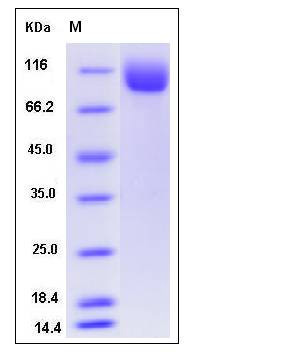Mouse NAALADL1 Protein (His Tag)
Gm964,Naaladasel
- 100ug (NPP3422) Please inquiry
| Catalog Number | P50937-M07H |
|---|---|
| Organism Species | Mouse |
| Host | Human Cells |
| Synonyms | Gm964,Naaladasel |
| Molecular Weight | The secreted recombinant mouse NAALADL1 comprises 736 amino acids and predicts a molecular mass of 80 kDa. As a result of glycosylation, the apparent molecular mass of mouse NAALADL1 is approximately 110 kDa in SDS-PAGE under reducing conditions. |
| predicted N | His |
| SDS-PAGE |  |
| Purity | > 97 % as determined by SDS-PAGE |
| Protein Construction | A DNA sequence encoding the secreted form of mouse NAALADL1 (Q7M758) (Pro 29-Leu 745) was fused with a polyhistidine tag at the N-terminus. |
| Bio-activity | |
| Research Area | |
| Formulation | Lyophilized from sterile PBS, pH 7.4 1. Normally 5 % - 8 % trehalose and mannitol are added as protectants before lyophilization. Specific concentrations are included in the hardcopy of COA. |
| Background | N-acetylated-alpha-linked acidic dipeptidase-like protein, also known as NAALADL1, NAALADase L, and Ileal dipeptidylpeptidase, is a Single-pass type I I membrane protein and a member of the peptidase M28 family and M28B subfamily. NAALADase L is mainly expressed in the distal small intestine. It is also expressed in the spleen and testis and Weakly expressed in the brain, locating mainly to the brain stem, amygdala, thalamus and ventral striatum. NAALADase L is a chloride-activated, membrane bound, metallopeptidase that cleaves the endogenous neuropeptide N-acetyl-aspartyl-glutamate (NAAG). NAAG acts as a partial NMDA agonist as well as a full agonist at the presynaptic metabotropic glutamate receptor 3 (mGluR3), where it acts to reduce glutamate release. NAALADase L also exhibits a dipeptidyl-peptidase IV type activity. NAALADase inhibition may be a novel therapeutic approach to reduce or inhibit heightened aggressiveness, and possibly to treat aggressive behavior associated with psychiatric disorders. |
| Reference |
